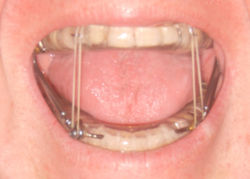- Mandibular advancement splint
-
A mandibular splint or mandibular advancement splint (MAS) is a device worn in the mouth that is used to treat obstructive sleep apnea (OSA) and snoring. These devices are also known as "mandibular advancement devices," "sleep apnea oral appliances," and "sleep apnea mouth guards."
The splint treats snoring and sleep apnea by moving the lower jaw forward slightly, which tightens the soft tissue and muscles of the upper airway to prevent obstruction of the airway during sleep. The tightening created by the device also prevents the tissues of the upper airway from vibrating as air passes over them – the most common cause of loud snoring.
Mandibular advancement splints are widely used in the United States and are beginning to be used in Britain and Israel. Where appropriate, they are considered a good therapy choice as they are non-invasive, easily reversible, quiet, and generally well accepted by the patient. The focus of improvement in appliance design is in reducing bulk, permitting free jaw movement (i.e., yawning, speaking, and drinking), and allowing the user to breathe through their mouth (early "welded gum shield"-type devices prevented oral breathing).
Over the last decade, there has been a significant expansion in the evidence base supporting the use of oral devices in the treatment of OSA.[1] Robust studies demonstrating their efficacy have been underpinned by increasing recognition of the importance of upper airway anatomy in the pathophysiology of OSA.[2] Oral devices have been shown to have a beneficial effect in targeting a number of significant clinical end points. These include the polysomnographic indexes of OSA, subjective and objective measures of sleepiness, blood pressure, aspects of neuropsychological functioning, and quality of life. Elucidation of the mechanism of action of oral devices has provided insight into the factors that predict treatment response and may improve the selection of patients for this treatment modality [3]. A further study by Dr. Edmund Rose, University of Freiburg (2004), successfully treated (AHI < 5) 88% of patients with MAS and proposes optimum patient selection to include AHI < 25, BMI < 30, and good dentition.[4]
Another study published in Sleep (2008) on the influence of nasal resistance (NAR) on oral device treatment outcome in OSA demonstrates the need for an interdisciplinary approach between ENT surgeons and sleep physicians to treating OSA. The study suggests that higher levels of NAR may negatively affect outcome with MAS[5] and subsequently methods to lower nasal resistance may improve the outcome of oral device treatment.
There are a number of oral devices available to patients suffering from obstructive sleep apnea and snoring. The efficacy of these devices varies greatly, as does the quantity and quality of the research behind them. A study of the effects of oral devices on blood pressure conducted by the Department of Respiratory and Sleep Medicine, Department of Nephrology, St. George Hospital, and the University of New South Wales Australia found that oral devices were equally as effective as CPAP in lowering the blood pressure of patients suffering from OSA.[6] The MDSA (Sleepwell) was clinically proven to conclusively show in a large and complex randomized controlled study that CPAP and MAS are effective in treating sleep-disordered breathing in subjects with AHI 5-30, although CPAP appears to be superior to the oral appliance. They are both also effective in alleviating symptoms,improving daytime sleepiness, quality of life and some aspects of neurobehavioral function, with CPAP usage being less than self-reported MAS usage. Nevertheless, more subjects and their domestic partners felt that CPAP was the most effective treatment, although MAS was easier to use. Nocturnal systemic hypertension was shown to improve with MAS but not CPAP, although the changes are small. [7]
Drawbacks
Many health plans do not cover mandibular advancement devices because they are a relatively new form of treatment. Patients often pay upwards of $2000 out of pocket to secure these devices. These devices can also be somewhat uncomfortable, although many patients find them less bothersome than CPAP mask treatment. Improperly fitted devices can cause teeth to shift over time, leading to significant dental problems. Regular dental checkups and adjustments to the oral device can prevent these problems. Morning jaw exercises can reduce pain and jaw dislocation, helping patients to retain a normal bite pattern.
References
- ^ http://www.somnomed.com
- ^ Chan A, Lee R, Cistulli PA. Oral Appliances for Obstructive Sleep Apnea [Review]. Chest (In Press). 2007 Aug; 132(2):693-9
- ^ 1. Chan A, Lee R, Cistulli PA. Oral Appliances for Obstructive Sleep Apnea [Review]. Chest (In Press). 2007 Aug; 132(2):693-9
- ^ 6. Rose E, University of Freiburg; Identifying the Ideal Oral Appliance Candidate (J.of Orofacial Orthopedics, 2004, 65, 6)
- ^ 13. Zeng B; Ng AT; Qian J; Petocz P; Darendeliler MAS; Cistulli PA. Influence of nasal resistance on oral appliance treatment outcome in obstructive sleep apnea. SLEEP 2008;31 (4): 543 547
- ^ H Gotsopoulos, BDS, MPH (Hons); J Kelly, MD, PhD; P Cistulli, Md, PhD. Oral Appliance Therapy Reduces Blood Pressure in Obstructive Sleep Apnea: A Randomized, controlled Trial. Sleep Vol 27 iss 5. pp. 934-941, (2004)
- ^ http://ajrccm.atsjournals.org/cgi/content/abstract/165/6/773
Categories:- Dental equipment
- Sleep disorders
Wikimedia Foundation. 2010.

